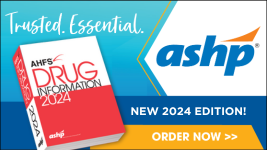This information is has been compiled using publicly available information on established best practices. ASHP and the University of Utah have provided this fact sheet for informational purposes only and are not assuming any liability for the accuracy or completeness of the information provided.
Introduction
This fact sheet summarizes the status of the current acute shortage of sterile water for injection vials and provides an outline of potential actions for organizations to consider in managing the shortage. Healthcare professionals should use their professional judgment in deciding how to use the information in this document, taking into account the needs and resources of their individual organizations.
Background
Sterile water (SW) for injection vials are commercially available in sizes ranging from 5 mL to 100 mL. Most, if not all, of these presentations are on back order with resupply dates ranging from late January to March 2018. The shortage of SW for injection vials has increased the demand for SW for injection bags ranging in size from 250 mL to 3,000 mL. There have also been intermittent shortages of these larger-sized products. There are currently two major manufacturers of SW for injection vials: Fresenius Kabi and Pfizer. Pfizer’s production has been limited due to manufacturing delays. Fresenius Kabi has not provided a reason for the shortage; however, typically when one manufacturer makes less than the usual amount of a product, other manufacturers are unable to meet the market demand.
Sterile water for injection vials are primarily used to reconstitute medications available as lyophilized powders. While the prescribing information for some medications may indicate alternative sterile liquids for reconstitution, most specify that SW for injection must be used. Without a consistent supply of SW for injection, healthcare personnel need to decide between selecting other therapies as treatments or using a sterile liquid other than SW for injection despite a lack of definite information about the effects on drug stability and compatibility. The consequences of using a sterile liquid not listed in product labeling to reconstitute medication vials may include poor dissolution of the powder, precipitation, or deactivation of the active pharmaceutical ingredient before further dilution or administration.
The University of Utah Drug Information Service and ASHP have been collecting information about the SW for injection shortage and coordinating with stakeholders to develop strategies to mitigate it. Both organizations have been in contact with the FDA, compounding experts, and pharmaceutical manufacturers to collect as much information as possible to share with pharmacy professionals.
ISMP Medication Error Reporting
ASHP encourages the reporting of any medication errors related to drug shortages to the Medication Error Reporting page on the Institute for Safe Medication Practices (ISMP) website.
Frequently Asked Questions
What is being done about the SW for injection shortage?
- ASHP has been in contact with the FDA and recently facilitated the addition of many SW for injection presentations to the FDA Drug Shortages Database.
- The University of Utah Drug Information Service and ASHP will continue to provide the most up-to-date information in the ASHP Drug Shortage Database.
What can pharmacists and institutions do about the SW for injection shortage?
- Actual ability to purchase available products often depends on hospital contracts and existing customer relationships. Contact your wholesaler or a manufacturer’s representative to determine what amount, if any, your institution can purchase.
- Pharmacists should consider ways to conserve SW for injection when possible. This may include strategies like finding products that do not require reconstitution with SW for injection (commercially available premixes, dual-chamber flexible containers) or batching the preparation of medications that require reconstitution to minimize waste of SW for injection.
- Review use of SW for injection vials in your organization to ensure remaining supplies are reserved exclusively for the reconstitution of medications.
- Alteplase unit-of-use 2mg vials require SW for injection for reconstitution. Instead of dispensing a SW for injection vial with each unit-of-use alteplase vial, consider bulk batching of frozen alteplase syringes to preserve SW for injection vials.1, 2, 3, 4
Can sterile liquids other than SW for injection be used to reconstitute medications?
- Check product labeling of frequently used medications to identify which, if any, may be reconstituted with sterile liquids other than SW for injection.
- Neither the FDA nor pharmaceutical manufacturers can make recommendations outside of product labeling. Primary literature or tertiary sources may have information about the suitability of alternatives to SW for injection.
- Sterile water for irrigation is NOT FDA labeled for any use as an injection in patients. Sterile water for injection, USP, must pass a particulate-matter test that sterile water for irrigation, USP, does not have to pass.5
- Bacteriostatic water for injection contains preservative and should not be used in place of SW for injection, especially in instances where injections may be given intrathecally or epidurally, or in specific patient populations (e.g. neonates).
- The inappropriate use of normal saline to reconstitute medications can result in hyperosmotic solutions that may, when administered by IV push, cause infusion-site reactions. 6, 7, 8, 9
- Normal saline reconstitution of medications for IV push administration may produce solutions at or near the solution’s saturation point. An example is reported crystallization in high-concentration cefazolin sodium after reconstitution with normal saline. 10
Can large bags of SW for injection be repackaged into empty sterile vials or syringes?
- Before repackaging SW for injection in bulk, be sure to check product labeling to determine whether the bag of SW for injection is a Pharmacy Bulk Package (PBP) (typically 2,000 mL or 3,000 mL).
- There may be limited utility to repackaging PBPs of SW for injection into vials or syringes. An FDA guidance states that the beyond-use time for repackaged drugs should not exceed the in-use time mentioned in the product labeling; four hours is the standard in-use time for PBPs unless otherwise stated in the product labeling.11
- Smaller SW for injection bags (1,000 mL or less) are not likely classified as PBPs; however specific product labeling should be consulted. If the bag is not considered a PBP and there is no in-use time established in the package labeling, USP <797> should be followed when setting beyond-use dates for sterile preparations.
Can large bags of SW for injection be used to reconstitute medication vials?
- Yes. Single-use containers should be labeled with the date and time of first entry, and discarded after an in-use time of six hours if kept within an ISO 5 environment.
- If using a PBP of SW for injection to reconstitute medications in vials, remember to label the bag of SW for injection with the date and time of first entry, and discard any amount of SW for injection remaining in the PBP after four hours.11
- When feasible, consider batch reconstitution of medications within the allowable in-use time to minimize waste of SW for injection
Please contact ASHP’s Center for Medication Safety and Quality with questions.
References
- Calis KA, Cullinane AM, Horne MK, et al. Bioactivity of cryopreserved alteplase solutions. Am J Health Syst Pharm. 1999; 56(20):2056-57.
- Jaffe GJ, Green GD, Abrams GW. Stability of recombinant tissue plasminogen activator. Am J Ophthalmol. 1989; 108(1):90-1.
- Maloney KW, Hillery CA, Nelson TJ, et al. The use of aliquoted and frozen tPA in central venous line occlusions. Blood. 1999; 94(Suppl 1):29a.
- Wiernikowski JT, Crowther M, Clase CM, et al. Stability and sterility of recombinant tissue plasminogen activator at -30 degrees C. Lancet. 2000; 355:2221-2.
- USP-NF Online: 2017 U.S. Pharmacopeia National Formulary USP 40 NF 35. Rockville, MD: The United States Pharmacopeial Convention; 2017. http://www.uspnf.com. Updated December 1, 2017.
- Cubicin RF (daptomycin for injection) [product information]. Kenilworth, NJ: Merck; March 2017. Accessed 2018 Jan 30 at https://www.accessdata.fda.gov/drugsatfda_docs/label/2017/021572s058lbl.pdf.
- Gazitua R, Wilson K, Bistrian BR, Blackburn GL. Factors determining peripheral vein tolerance to amino acid infusions. Arch Surg 1979; 114:897-900.
- Nowobilski-Vasilios A and Poole SM. Development and preliminary outcomes of a program for administering antimicrobials by i.v. push in home care. Am J Health Syst Pharm. 1999; 56(1):76-9.
- Robinson DC, Cookson TL, Grisafe JA. Concentration guidelines for parenteral antibiotics in fluid-restricted patients. Drug Intel Clin Pharm 1987; 21:985-989.
- McEvoy GK, ed. Handbook on injectable drugs. 19th ed. Bethesda, MD: American Society of Health-System Pharmacists, Inc; 2017:216.
-
Food and Drug Administration. Repackaging of certain human drug products by pharmacies and outsourcing facilities: guidance for industry. U.S. Department of Health and Human Services. January 2017. Accessed 2018 Jan 30 at https://www.fda.gov/downloads/Drugs/Guidances/UCM434174.pdf
*Please note that this is the only current repackaging guidance available. The FDA does intend to release a separate guidance on this issue specific to hospitals/health-systems, so some requirements may change
©Copyright 2018, American Society of Health-System Pharmacists®, Inc. All Rights Reserved.


